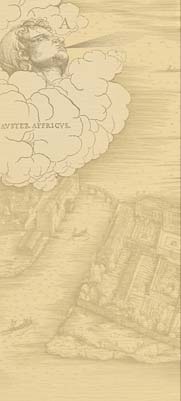Mathematics: Toolkit
The Rule of Three
On the first page of his manuscript, Michael carefully states a commercial problem: "If 400 pounds of pepper is worth 49 ducats, what is the value of 315 pounds?"
ducats, what is the value of 315 pounds?"
We recognize this as a problem of proportions, in which a is to b as c is to d. We might write this out as:
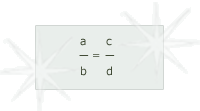
Michael recognized his problem as classic material for what he called the "high fashion of the rule of three." According to this rule, if four numbers are related like those in his problem, three of the numbers could be used to find the fourth.
In modern math, we could solve the problem four ways to find any of the four numbers. But the rule of three used only one solution: You always multiplied the second and third terms in your problem, then divided by the first.
In modern notation, Michael's rule would be:
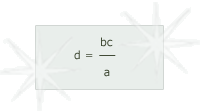
Because he used only this one rule, but not modern notation, Michael had to be sure to state the problem in the right order. Then he could proceed to finding the value of his pepper in ducats, grossi (which he calls denari), and piccoli.
-
a) The value in ducats
Michael begins by finding the value of his cargo in ducats.
-
1] He starts by writing out his numbers in the same order that he stated the problem: 400 49
 315.
315.
-
2] Next he writes out the calculation he must perform after transforming 49
 into
into  to get rid of the inconvenient fraction. Note that the lines connecting the numbers are not related to modern mathematical notation. They show which numbers Michael intended to multiply together (400x2x1 and 1x92x315).
to get rid of the inconvenient fraction. Note that the lines connecting the numbers are not related to modern mathematical notation. They show which numbers Michael intended to multiply together (400x2x1 and 1x92x315).
-
3] Michael multiplies 400 by 2 by 1 to get 800 and keeps this answer in his head.
-
4] Multiplying 315 by 99 is more difficult. Michael has to write out this computation. On the left are the numbers to be multiplied. In the middle are the intermediate products. On the right is the answer of 31185.

-
5] To complete the rule of three, all Michael has to do is divide 31185 by 800. The division can be seen on the right of the page, but it almost looks as if Michael has divided 31185 by 8000. What we see here is the end result of Michael's galera (or "galley") method of division. To follow Michael's method of division, click on the calculation below:
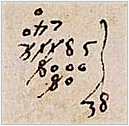 Follow Michael's method of division »
Follow Michael's method of division »
-
6] Neither the decimal point nor decimal fractions existed in Michael's time, so he had to express the result of his division as a compound fraction, concluding that his cargo of 315 pounds of pepper is worth 38 and
 ducats. The 785 is visible in the division above.
ducats. The 785 is visible in the division above.
-
-
b) The remainder in denari (grossi)
In addition to gold ducats, Venetians used silver coins called grossi (which Michael refers to as denari) and coins mainly of copper called piccoli. Each ducat was equal to 24 grossi, and each grosso was equal to 32 piccoli. This was another problem for the rule of three.
Michael wanted to know how much
 ducats would be worth in denari. He doesn't state the problem in words, but in modern notation it would be:
ducats would be worth in denari. He doesn't state the problem in words, but in modern notation it would be: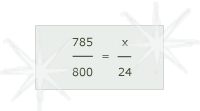
and the solution would be:
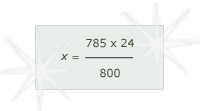
Michael carries out exactly this computation.
-
1] He begins with the multiplication of 785 by 24. On the right are the numbers to be multiplied. In the middle are the intermediate products. To the left is the answer, 18840.

-
2] Now all Michael has to do is divide 18840 by 800, carrying out the galera division below.
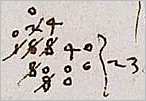
-
3] The answer is that
 ducats is worth 23 and
ducats is worth 23 and  denari. The 440 is visible in the division above.
denari. The 440 is visible in the division above.
-
-
c) The remainder in piccoli
Finally, Michael wanted to know how much his
 denari, which Venetians normally referred to as grossi, was worth in piccoli, given 32 piccoli to the grosso.
denari, which Venetians normally referred to as grossi, was worth in piccoli, given 32 piccoli to the grosso.This was his third use of the rule of three.
In modern notation the calculation would be it would be:
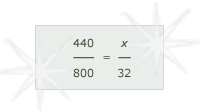
and the solution would be:
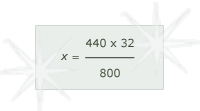
Michael carries out exactly this computation.
-
1] He starts on the left, multiplying 440 by 32. In the middle are the intermediate products. On the right is the answer, 14080.

-
2] Now all he needs to do is divide 14080 by 800, carrying out the galera division below.
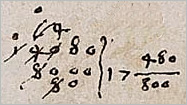
-
3] His answer is that
 denari is worth 17 and
denari is worth 17 and  piccoli. The 440 is visible in the division above.
piccoli. The 440 is visible in the division above.
-
And so in the end Michael is able to conclude that his 315 pounds of pepper is worth 38 ducats, 23 denari, and 17 piccoli.
piccoli.
See how Michael solves the problem using algebra or the rule of double false position.











